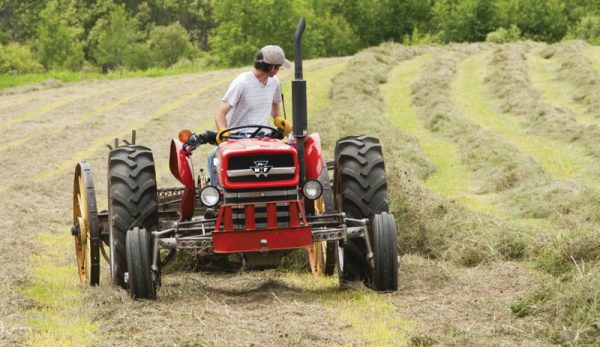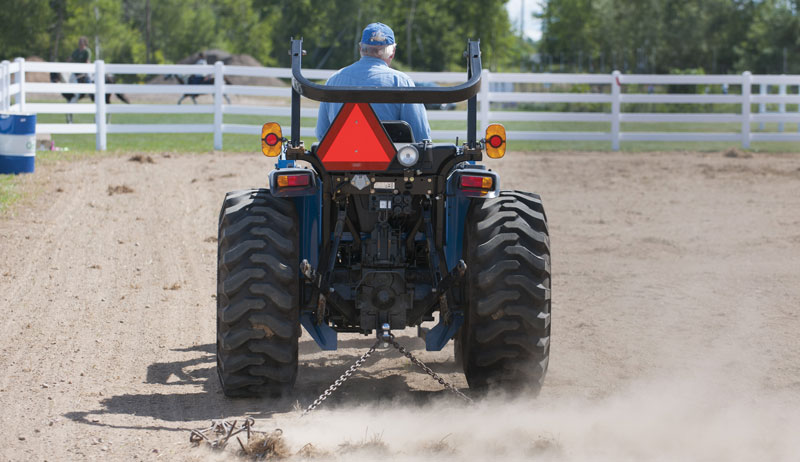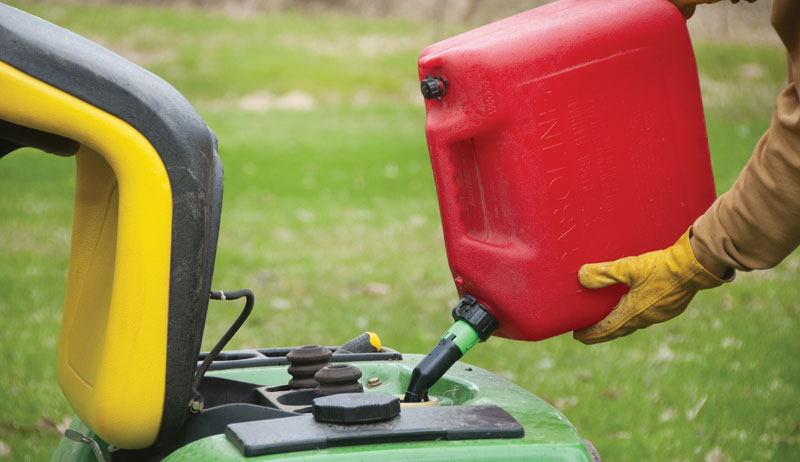
Let’s face it. When it comes to tractor features and accessories, we tend to focus on the flashy: horsepower, attachments, implements, etc. We’re always eager to discuss engine horsepower versus PTO horsepower and exactly how much weight a given front-end loader can lift. In contrast, it’s easy to overlook the nuances of types of tractor tires, fuel stabilizers and ballast for improved balance and traction.
But less flashy doesn’t mean less important. To the contrary, tires, ballast and fuel stabilizers are important—and in some cases essential—to maximize the performance of your tractor.
Let’s give these three overlooked aspects some time in the spotlight and explore how they can make or break a tractor’s performance.
Tires
There’s an old saying about horses that goes, “no hoof, no horse.” Tractors have long since replaced horses for modern fieldwork. But we can apply a similar phrase: no tires, no tractor.
Without suitable tires, even a powerful tractor can struggle to complete its tasks. Equipping your tractor with the right tires for your needs requires some knowledge of tire types, tread designs, accessories and maintenance.
Let’s dig in and highlight the main areas to focus on.
Radial or Bias?
Although you might assume tire technology is standardized, that’s not the case. When it comes to tractor tires, two types—radial tires and bias tires—offer varying strengths and weaknesses.
Radials are Usually Best
In most cases, radial tires offer superior performance. Their design allows the tread to flex independently of the sidewall, which increases traction with the ground, improves fuel economy, reduces soil compaction, provides a smoother ride and prolongs the life of the tread—perhaps to as much three times longer than a bias tire.
But there are some downsides. The fact the tread can flex independently of the sidewall can make radial tires less suitable for negotiating hills and slopes. And the sidewalls can be a vulnerable point if you strike an unseen object while operating.

Time for Bias
This is where bias tires shine. They’re constructed from many layers of overlapping plies, giving them great durability if you’re negotiating rough terrain dotted with rocks, stumps, debris and other obstacles. Their stiffness provides solid performance on slopes. They’re also cheaper than radial tires.
Bias tires can also be less inclined to tear up the ground when turning, because less of the tread will be in contact with the ground at any given moment.
On the other hand, radial tire technology continues to advance, improving their weak spots while doubling down on their advantages. Increased flexion (IF) radials filled to the same pound-force per square inch (PSI) as regular radials can carry 20 percent more weight. Or they can carry the same weight with 20 percent less PSI.
Very high flexion (VF) radials double these metrics to 40 percent. The end result is an even larger tread footprint. This further increases traction and reducing soil compaction.
If you’re not a heavy tractor user, bias tires can be a perfect choice at a solid price point, especially if you find their strong points (durability, less ground tearing on turns, performance on slopes, etc.) appealing. But for serious field work, the longer lifespan and better fuel economy offered by radial tires might offset their higher starting price while providing better performance overall.
Regardless of which type you choose, keep your tires inflated to the recommended PSI. You’ll prolong the life of the tires and improve performance, steering and safety, too.
R1, R2, R3 or R4?
Just as important as the radial versus bias debate is choosing the right tread design for your tractor tires. While variations exist, many tractor tires fall into four broad categories (R1, R2, R3 and R4), with each one offering optimum performance under different conditions.
Let’s explore the four categories and highlight their strengths.

R1
Classic farm tires, also known as agricultural tires. R1 tires are usually narrow with deep treads and widely spaced lugs, all designed to maximize traction and resist clogging under challenging conditions such as mud and snow. They’re aggressive and designed for off-road use. But that’s perfect for many farming tasks. The R1W tire is a variation with tread depths approximately 20 percent deeper than a typical R1 tire, offering even better performance in soggy conditions.
R2
A specialty tire with treads twice as deep as R1 tires, designed for use in very wet conditions like those encountered growing sugarcane or rice. R2 tires aren’t especially suited to general use, though. So unless you need them for cultivating specific crops, R1 or R1W tires are likely a better choice.
R3
Known as turf tires because their shallow tread depths, narrow lug spacings, and wider footprints spread the weight of a tractor across a larger area than R1 tires, helping reduce damage to lawns. R3 tires are perfect for garden work and mowing grass. But traction can suffer in wet conditions.
R4
Industrial tires fall in between R1 and R3 tires when it comes to tread depths and lug spacings. They’re durable tires suitable for operating on hard surfaces, such as concrete and pavement. The treads don’t wear out as quickly, and R4 tires boast tough sidewalls suitable for supporting great weight. They’re a perfect choice when moving heavy loads with a front-end loader or forks. And they’re considered a good general-purpose tire.
Read more: Do you need a 2WD or 4WD tractor?
What About Winter Weather?
Cold temperatures, snowy conditions and slippery ice can make for challenging operating conditions. During the winter, your tractor tires may need some help to perform at their best.
For starters, you need to keep an eye on tire pressure, which can decrease as temperatures drop. Make a habit of checking tire pressure after temperature swings. And add air as necessary to keep the tires at their ideal PSI.
If you’re going to be using your tractor in deep snow or ice, tire chains can significantly improve traction and performance. These metal chains wrap around the tires and provide greater grip in slippery conditions. Just keep in mind, tire chains can’t be used at high speeds (stay below 30 miles per hour) or on dry surfaces. For example, using tire chains on bare pavement can damage the surface and also wear out your tire chains.
Read more: These 5 steps will help you get your garden tractor ready for winter.
Ballast
Maintaining proper weight distribution across a tractor is important for so many reasons. It’s necessary to achieve proper traction and protect against premature damage to the tire treads (from wheel slippage) or front axle (from excess weight).
It’s also critical from a safety perspective. If you try to lift too much weight with the front-end loader, your rear wheels may lift off the ground. Or if an implement on the three-point hitch is too heavy, the front of the tractor can lift up, reducing (or eliminating) your ability to steer.
Ballast can address these concerns. To maximize traction, ballast increases the weight of the tractor, pushing down on the wheels so they can thoroughly grip the ground. Ballast also serves to counterbalance tractors carrying heavy loads in the front or rear.
There are many types of ballast available. Even implements attached to the tractor can serve as ballast, though operating with a random rotary cutter or box blade in the rear reduces maneuverability.
More formal options for ballast include the following:
Suitcase Weights
Suitcase weights are square or rectangular in shape, with handles for convenient carrying. This gives them an appearance not dissimilar to a suitcase. They come in varying weight amounts and are installed in rows on brackets at the front or rear of the tractor, increasing traction and providing counterweight as needed.
Suitcase weights offer a lot of versatility for adding specific amounts of weight to your machine, since they’re sold in clearly defined sizes and can be easily added or removed.
Ballast Box
A ballast box couldn’t be simpler. It’s a tough metal box mounted on the three-point hitch, designed to be filled with whatever heavy ballast you have handy.
Rocks? Go for it. Concrete blocks? They work fine. Dirt? It might be a bit mess, but it’s suitable. If you need rear ballast to counterbalance heavy lifting with the front-end loader, a ballast box can be the perfect choice.
Concrete Block or Cylinder
Similar to a ballast box, fusing three-point hitch pins inside a concrete block or cylinder can create an effective piece of ballast. Just pick up the concrete with the three-point hitch, and you’re ready to go.
Wheel Weights
This straightforward option adds weight directly over the tires. They install on the wheels (the rims or axles, for example) to increase tire-to-ground traction, with the benefit of removing weight from the tractor’s frame.
Liquid Tire Ballasts
Filling your tires with liquid ballast is a great way to increase weight and traction without straining other parts of the tractor. It also lowers your tractor’s center of gravity, a big plus when negotiating sloping terrain.
Options for liquid tire ballasts include:
- Water: It’s inexpensive, safe and readily available. But water is not the heaviest option. It also freezes at the relatively warm temperature of 32 degrees F and can cause wheel rims to rust.
- Antifreeze: When mixed with water, antifreeze stays liquid at temperatures well below zero. But it’s also toxic, especially ethylene glycol antifreeze.
- Calcium Chloride: An extremely cold-tolerant option—mixed with water, it can resist freezing down to -40 degrees F or less. Its low price and increased weight (40 percent heavier than plain water) are other positives. But calcium chloride is corrosive, has a reputation for damaging wheel rims and can be hazardous to handle.
- Beet Juice: A pricier solution, but a good choice since it’s nontoxic, heavier than water, and freeze-resistant down to -35 degrees F.
- Windshield Washer Fluid: Weighs similar to or slightly less than water and freezes at a much lower temperature (around -20 degrees F, depending on the formula). But methanol, a highly toxic alcohol, is a common ingredient.
Picking out a backhoe attachment might be more fun than debating whether to equip your tractor with radial or bias tires. And moving piles of garden compost with a front-end loader is probably more satisfying than filling a ballast box with sandbags.
But if you’ve come away with a new respect for the importance of tires, ballast and fuel stabilizers, then our mission is complete. Your tractor will thank you.
More Information
Fuel Stabilizers
While tires and ballast aim to maximize tractor performance, fuel stabilizers work behind the scenes to protect against performance loss due to poor-quality fuel. This applies not only to your tractor, but all your gasoline and diesel-fueled farm equipment.

It doesn’t take long for gasoline and diesel fuel to degrade. The exact processes can vary. But exposure to oxygen, light, heat or water can all be problematic.
Gasoline can start to degrade within a couple of months as its most volatile compounds evaporate and reduce combustibility. Degraded gasoline can coat the fuel system with a substance compared to varnish, clogging fuel lines and the carburetor.
Diesel can also degrade quickly under the right circumstances, turning gummy or sludgy and even feeding the growth of microbes that further degrade the fuel. Suffice to say, an engine running on bad fuel might not run at all.
Benefits of Fuel Stabilizers
Bad fuel shouldn’t be a concern if you use your equipment on a regular basis, since you’ll burn through the fuel long before it starts degrading. But if you store fuel for months at a time, or if you’re concerned about fuel degrading inside seasonal equipment (such as a tractor that doesn’t receive much winter use), fuel stabilizers can save the day.
The benefits of fuel stabilizers are twofold. For one, they extend the stable life of the fuel, perhaps to as long as a year or more. Secondly, they allow you to skip the problematic step of draining fuel from seasonal equipment.
Draining fuel is a time-consuming task. It also opens the door for water to condensate inside the empty fuel tank, which can ultimately corrode the fuel system.
On the other hand, if your fuel is stable, you can instead fill up the fuel tanks of out-of-season equipment and reduce the amount of air and water vapor that can enter their systems.
A Basic Premise
Plenty of fuel stabilizers exist on the market, and exact instructions for use may vary from product to product. But the basic idea is simple.
Once you mix a certain amount of stabilizer into the fuel, you’ll be good to go. If you’re adding fuel stabilizer to the tank of an engine, run the engine for several minutes to let the mixture work through the entire system, ensuring the stabilizer can work its magic while the machine is out of use.
This article originally appeared in the May/June 2022 issue of Hobby Farms magazine.




